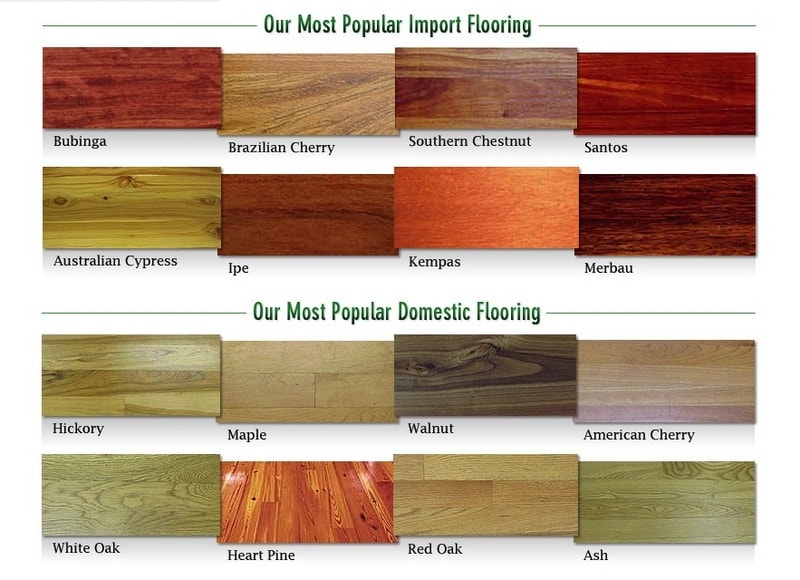Hardwood Floor Installation
Installing a new hardwood floor? You’ve come to the right place! Pure Hardwood Floors, LLC. is a fully insured and licensed professional flooring contractor service. Call us now at (610) 653-2650 for a FREE estimate.
Type of Hardwood Floors

Solid Wood Flooring
Solid wood flooring comes in three main types. Each type is available in both an unfinished and a pre-finished version. Unfinished flooring must be job-site sanded and finished after installation. Pre-finished flooring is sanded and finished at the factory, so it only needs installation. The three main types of solid wood flooring are:-
Strip flooring
This type of flooring is denoted by the thickness and width of the wood planks. Strip flooring has a set width, but the thickness can vary. Strip flooring ranges in thickness from 5/16 of an inch to 3/4 of an inch thick. It is available in widths of 3/4 inches up to 2 1/4 inches wide. -
Plank flooring
Plank flooring only comes in two thicknesses, but unlike strip flooring, the widths can vary. It is available only in thicknesses of 1/2 inch or 3/4 inch and a range of widths from 3 inches up to 12 inches and can still be a tongue and groove floor. -
Parquet flooring
Parquet floors have a very different look from typical hardwoods. They are made up of geometrical patterns composed of individual wood slats held in place by mechanical fastening or an adhesive.
Engineered Wood Flooring
Engineered wood flooring should not be confused with laminate wood flooring. Engineered flooring is produced by adhering layers of plastic laminate veneer with real wood. The main difference between this type of wood and laminate flooring is that laminate flooring contains no actual wood. Look for more on laminate wood flooring later in this article.
Acrylic-impregnated Wood Flooring
Acrylic-impregnated wood flooring is infused with sealant and color throughout the thickness of the wood. So, what is normally a surface “finish” is actually consistent throughout the wood. This type of flooring is most commonly used in commercial, not residential, projects. This type of floor is very hard and it is highly resistant to moisture and scratches.
Hardwood Varieties
A crucial decision to make when you decide to install a hardwood floor is what kind of wood to use. There are issues of both substance and style that need to be taken into account. For instance, light wood may be more appropriate for a casual setting, while dark wood lends itself to more formal surroundings. There are no hard and fast rules, simply select what strikes you the most and fits into your budget—different types of woods can vary greatly in price.
Wood Finishes
The finish is a top coat that will protect your floor from everyday wear and tear. When considering finishes, you need to decide whether to apply it yourself or buy pre-finished flooring. The latter offers a wide variety of wood species and save hours of labor and cleanup, while unfinished wood allows you to customize both the color and finish of the floor. Although pre-finished flooring can cost as much as $1.50 more per square foot than unfinished, but you also get an extended factory finish warranty with pre-finished floors. There are two kinds of hardwood finishes:Surface Finishes
Surface finishes are the most popular kind. They require a stain to achieve the desired color and then a top coat of polyurethane or varnish for protection. Surface finishes are easy to maintain and quite durable. The four surface finishes are:-
Oil-Based Urethane
The most common surface finish, oil-based urethane is applied in two or three coats and is available in gloss, semi-gloss and satin sheens. The downside to this type of finish is the drying time—up to 8 hours for each coat. You will also need adequate ventilation. And, keep in mind that oil-based urethane finishes do yellow with age. -
Water-Based Urethane
A good option for the DIY-er, this finish dries quickly and cleans up easily with soap and water. Water-based urethane has less odor than oil-based urethane and doesn’t yellow over time. -
Moisture-Cured Urethane
Slightly more durable than others, this finish is most often used on commercial projects and is best handled by a professional. -
Conversion Varnish
Due to the strong odor and fumes, this finish should only be applied by a professional.
Penetrating Finishes
Penetrating finishes penetrate the wood deeper than surface finishes. The finish soaks into the wood and then a wax is applied to give a low-gloss sheen. With this finish, wax needs to be reapplied periodically and only certain cleaners can be used on the floor. For this reason, surface finishes may be a better bet for the non-professional installer.
Installation Methods
-
Nail Down
Nails are used to fasten the wood to the subfloor. This method is often used with thin wood flooring. -
Staple Down
Staples are used instead of nails to attach the floor to the subfloor. This method is simpler than the nail down method. -
Glue Down
Engineered wood floors and parquets can be glued down. The wood is adhered to the subfloor with a strong adhesive. -
Floating
This is the fastest and easiest method of installation. Floating floors are not attached to any subfloor, they simply float above it. Either adhesive is applied to the boards to keep them together, or the boards are made to simply snap together. Usually a pad is placed between the wood floor and the subfloor to protect against moisture and reduce noise. Floating floors can be installed over almost any surface.
